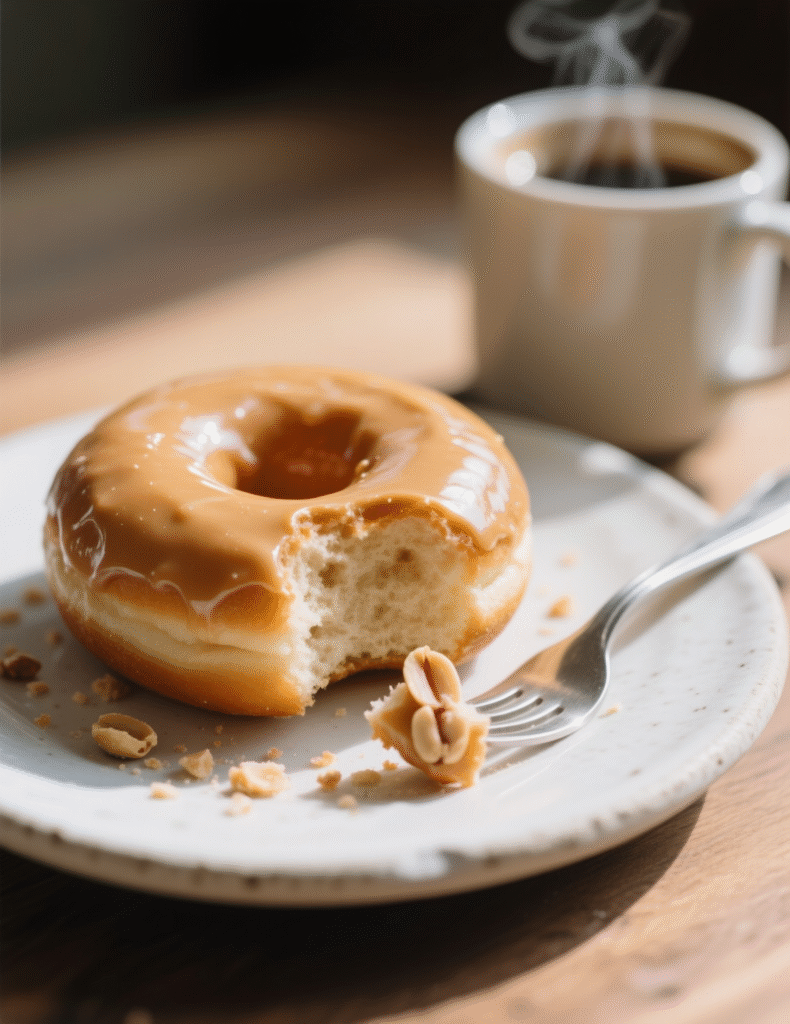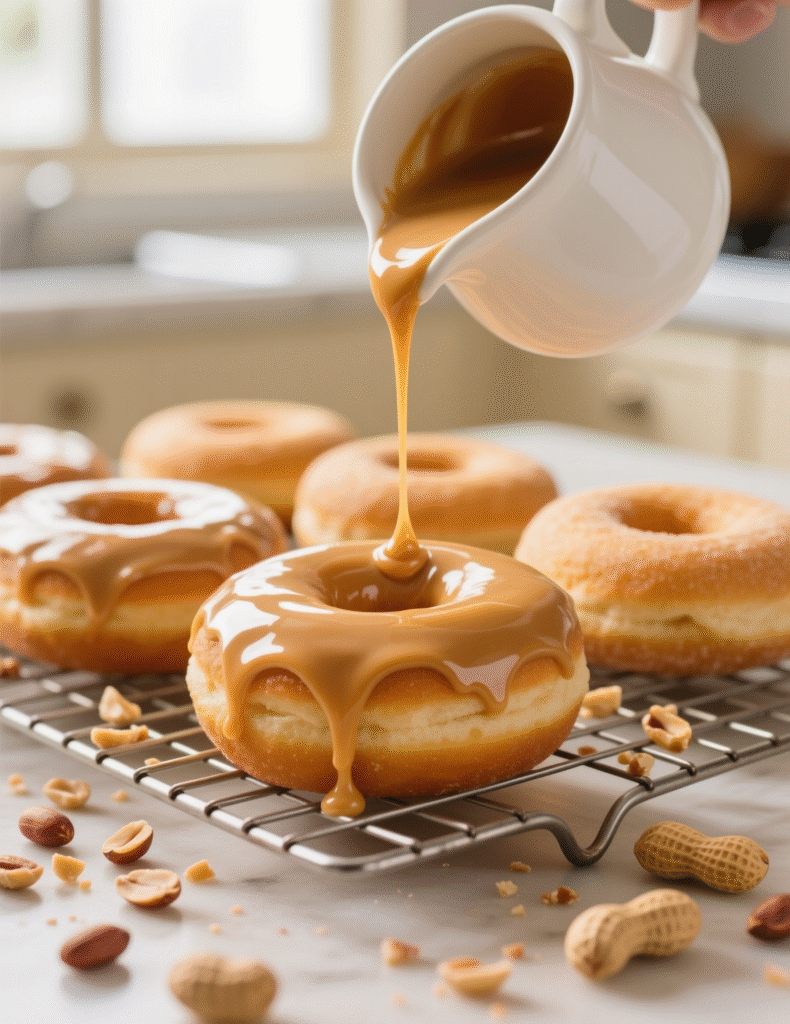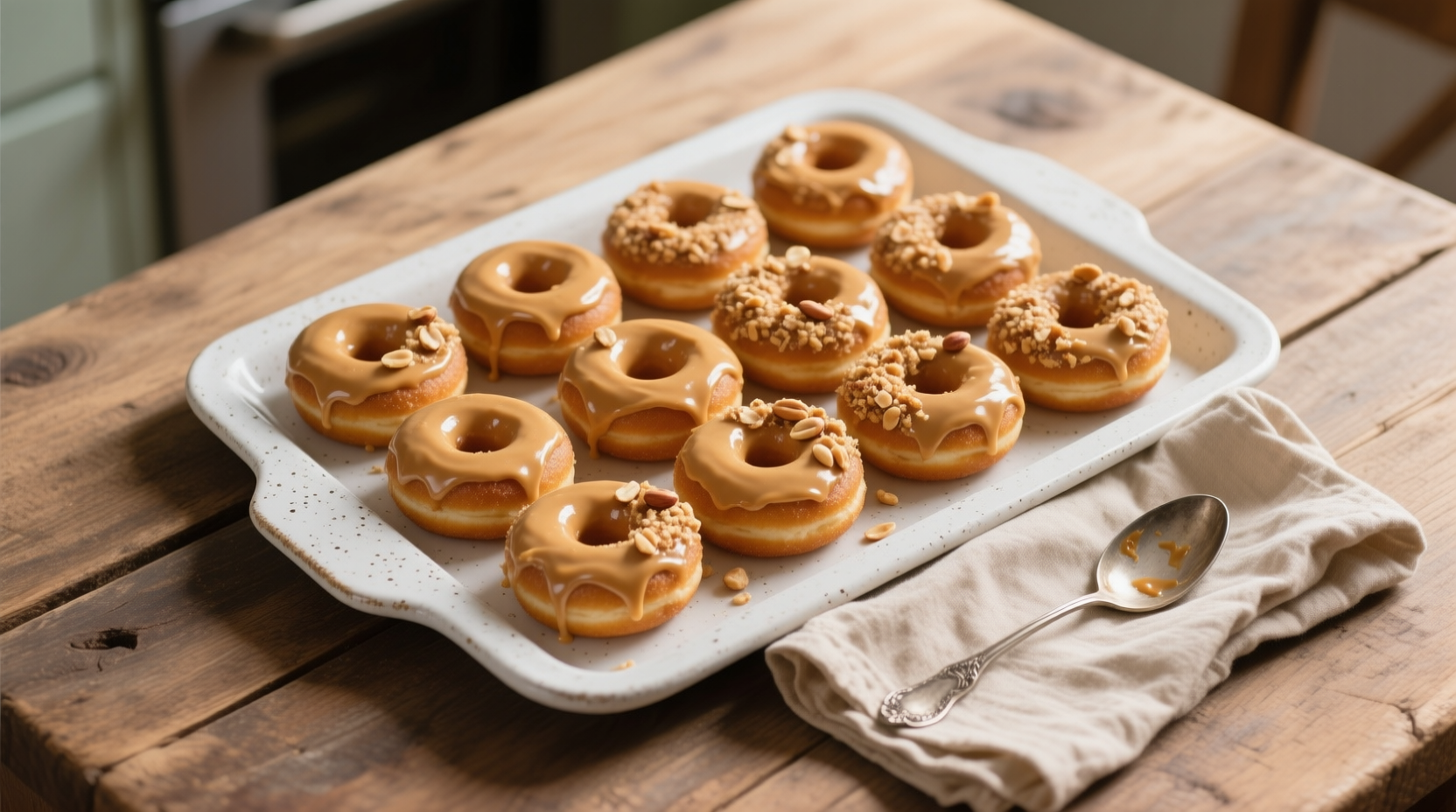Peanut butter baked donuts aren’t just a quirky mashup of two American favorites. They are, in many ways, a reflection of how the food world constantly reinvents itself without throwing away its roots. Professionals already know donuts aren’t just fried sugar bombs anymore. They can be leaner, layered with flavor, and engineered to deliver the same comfort without the greasy aftermath. This recipe and technique walk a strange but exciting line between indulgence and practicality. And trust me, once you’ve baked them right, you’ll wonder why anyone still waits for hot oil to reach 350°F.
Why Baked Donuts Deserve the Spotlight
Most bakers will roll their eyes when someone calls baked donuts the “healthy version.” The truth is they’re not diet food, but they do offer control. Control of texture, control of fat content, and control of flavor integration. With baking, the structure relies on protein networks and leavening instead of steam pockets from hot frying oil. That means flavor additions—like peanut butter—don’t wash away in oil but actually bind themselves into the crumb.
Here’s a small thing many miss. A fried donut demands speed—dough in, dough out, drain, glaze. But baked donuts let the proteins relax in the oven, allowing for deeper infusion of nutty tones. This distinction, subtle as it is, is the backbone of why peanut butter shines brighter when baked.
The Role of Peanut Butter in Baking
Peanut butter, when heated, transforms more than most home bakers realize. The fat melts, yes, but it also releases compounds that interact with sugars in ways similar to browning butter. This gives baked goods a roasted undertone, almost like a quiet bass note under the melody of sweetness.
Now, not every peanut butter behaves the same. Natural peanut butter separates and can destabilize batters if you don’t adjust ratios. Commercial peanut butters like Skippy or Jif bring consistency but add extra sugar and stabilizers, which influence moisture retention. A pastry chef in Chicago once told me she keeps both jars on the line, switching depending on whether she needs structure or nuance. This is the type of detail that separates a “recipe” from a craft.
Core Ingredients for Peanut Butter Baked Donuts
- All-purpose flour (240g): the workhorse, carrying structure.
- Baking powder (2 tsp): lift and tenderness.
- Baking soda (½ tsp): complements the acidic notes from dairy.
- Salt (¼ tsp): flavor sharpener, not optional.
- Peanut butter (100g): creamy, room-temp, full fat for depth.
- Granulated sugar (100g): sweetness and tenderness.
- Brown sugar (50g): molasses note, helps caramelize edges.
- Egg (1 large): binding agent, also moisture control.
- Buttermilk (180ml): acid balance and crumb lightening.
- Vanilla extract (1 tsp): background note, balances nutty heaviness.
- Melted butter (30g): for mouthfeel, bridges fats.
These ingredients may look simple. But every gram matters. Swap buttermilk for regular milk, and you’ll lose that gentle tang which keeps peanut butter from turning cloying. Cut brown sugar, and you miss the chew in the bite.

Mixing Science: How to Avoid Tough Donuts
One of the easiest mistakes in donut batters is overmixing. With baked donuts, you’re essentially making a quick bread, not a yeasted dough. If gluten chains form too strongly, the donut will chew like rubber bands. A practical trick: whisk dry ingredients separate, whisk wet separate, then fold with the lightest hand possible. If streaks of flour remain, don’t panic. In fact, leaving a few faint streaks ensures the batter isn’t overworked.
Another small but crucial note—room temperature peanut butter. Try whisking cold peanut butter into buttermilk and you’ll create a lumpy mess that refuses to homogenize. Professionals sometimes warm peanut butter gently in a bain-marie before blending it, just enough to loosen without frying its oils.
Baking vs Frying: A Comparative Lens
Fried donuts reach about 190°C internally in a matter of minutes, while baked donuts spend 12–15 minutes at 180°C. This difference changes starch gelatinization rates. With frying, you get immediate crust and slower interior cook. With baking, it’s even throughout. For peanut butter donuts, even heat matters because it prevents oil migration. If baked correctly, the peanut butter flavor stays locked in the crumb rather than bleeding into the exterior.
In 2019, a small bakery in Portland ran a trial selling both fried and baked peanut butter donuts. Within three months, baked outsold fried by 40%, not because customers thought they were healthier, but because the flavor lingered longer and reheated better the next day. That’s the kind of data that makes professionals rethink technique.
Step-by-Step Process
- Preheat oven to 180°C (350°F). Grease donut pan lightly with neutral oil spray.
- In a large bowl, sift flour, baking powder, baking soda, and salt.
- In another bowl, whisk peanut butter, sugars, egg, melted butter, buttermilk, and vanilla until smooth.
- Gently fold wet mixture into dry with spatula. Stop once combined.
- Transfer batter into piping bag, pipe evenly into donut molds (¾ full).
- Bake 12–14 minutes, until tops spring back when touched.
- Cool in pan 5 minutes, then transfer to rack.
The donuts at this stage are subtly nutty, not overpowering. Glaze, however, elevates them.
Glaze and Finishing Options
A simple peanut butter glaze can double the impact. Mix 80g powdered sugar with 2 tbsp peanut butter and 1–2 tbsp milk. Thin it until pourable. Dip donuts while warm so glaze adheres and sets glossy.
But professionals push further. A chocolate ganache drizzle turns it into a Reese’s-like experience. Crushed roasted peanuts on top add crunch and aroma. Some even add miso paste to the glaze for umami, which balances the sweetness in unexpected ways.
Common Mistakes to Avoid
- Overbaking: Peanut butter dries faster than butter-based batters. Always test at 12 minutes.
- Using reduced-fat peanut butter: These products alter fat ratios and make donuts sandy.
- Glazing too cold: The glaze sets clumpy if donuts cool fully. Aim for warm but not hot.
A pastry school in New York once ran a blind tasting where students compared baked donuts with reduced-fat peanut butter vs full-fat. Ninety percent noticed the difference, describing the reduced-fat ones as “cardboardy” or “hollow.” Lesson—fat is flavor, don’t cheat it.

Nutritional Perspective
One baked peanut butter donut averages 220–250 calories, depending on glaze. Compare this to a fried peanut butter donut, which can reach 350–400 calories due to oil absorption. Saturated fat is cut nearly in half. For professionals designing menus, this distinction matters. It allows marketing baked donuts as “lighter indulgence,” a phrase customers respond to without feeling guilt-trapped.
Trends and Market Relevance
Peanut butter itself is experiencing resurgence. According to Statista, U.S. peanut butter sales hit nearly $2.7 billion in 2023, driven by nostalgia and protein-focused consumers. Pair that with the baked donut wave, and you have a product sitting perfectly between comfort and modern wellness trends. Cafés leveraging this combo see higher customer retention, as customers return for the balance of flavor and satisfaction.
Variations for Professionals
- Swirl in raspberry jam into the batter for a PB&J donut.
- Infuse the glaze with espresso for depth.
- Replace part of flour with oat flour for nutty complexity.
- Top with smoked sea salt flakes for savory balance.
Each variation adds a story to the donut, and storytelling sells as much as flavor. When customers bite into a PB&J donut, they’re not eating— they’re remembering.
Conclusion
Peanut butter baked donuts stand as proof that classics don’t need frying oil to stay comforting. The technique respects science, balances flavor, and offers creative elasticity for professionals. From ingredient selection to baking method, every choice shapes the final bite.
For chefs and bakers looking to innovate menus, this recipe isn’t just a one-off. It’s a blueprint for how to reimagine nostalgia through precision and flavor science. Bake them once for yourself, but know this—your customers will come back not just for the taste, but for the way it feels familiar yet oddly new.
FAQs
What makes baked donuts different from fried ones?
Baked donuts cook evenly in the oven, absorb less fat, and hold peanut butter flavor better than fried.
Can I use natural peanut butter for this recipe?
Yes, but you’ll need to adjust mixing since natural peanut butter can separate and affect texture.
How do I keep baked donuts from drying out?
Avoid overbaking and always check doneness at 12 minutes for soft, moist donuts.
Is reduced-fat peanut butter a good option?
No, it changes fat balance and makes donuts crumbly and less flavorful.
Can I make these donuts gluten-free?
Yes, substitute all-purpose flour with a reliable 1:1 gluten-free baking blend.
What glaze works best with peanut butter donuts?
A peanut butter glaze or chocolate ganache pairs perfectly with their nutty flavor.
How long do peanut butter baked donuts stay fresh?
They stay soft for 2 days at room temperature and up to 5 days refrigerated.
Can I freeze peanut butter baked donuts?
Yes, freeze them unglazed for up to 2 months and glaze after thawing.
Are peanut butter baked donuts healthier than fried ones?
Yes, they have fewer calories and less saturated fat since they skip oil absorption.
What variations can I try with this recipe?
PB&J swirls, espresso glaze, oat flour blends, or smoked sea salt toppings all work beautifully.

Mariana is a passionate home cook who creates delicious, easy-to-follow recipes for busy people. From energizing breakfasts to satisfying dinners and indulgent desserts, her dishes are designed to fuel both your body and hustle.
When she’s not in the kitchen, she’s exploring new flavors and dreaming up her next recipe to share with the Foodie Hustle community.

